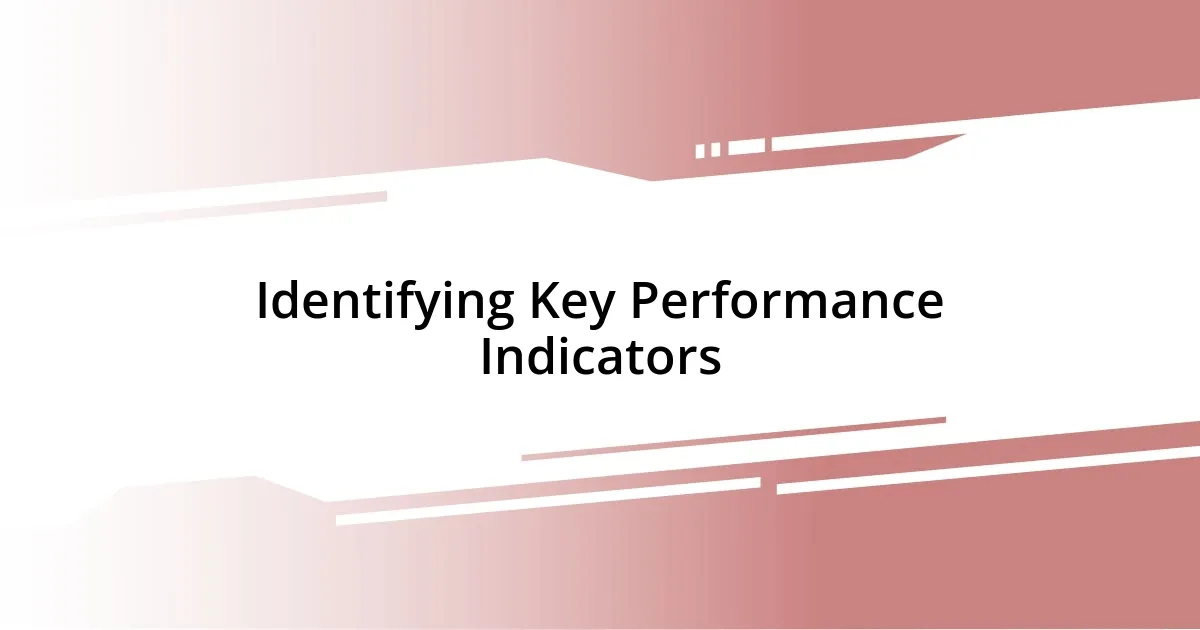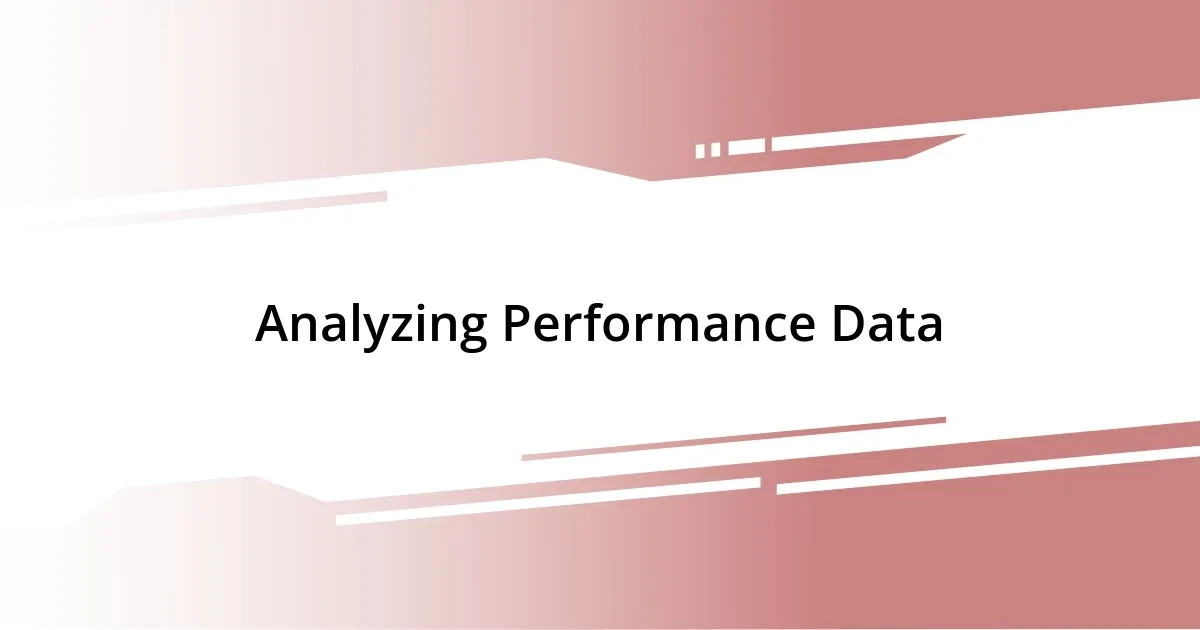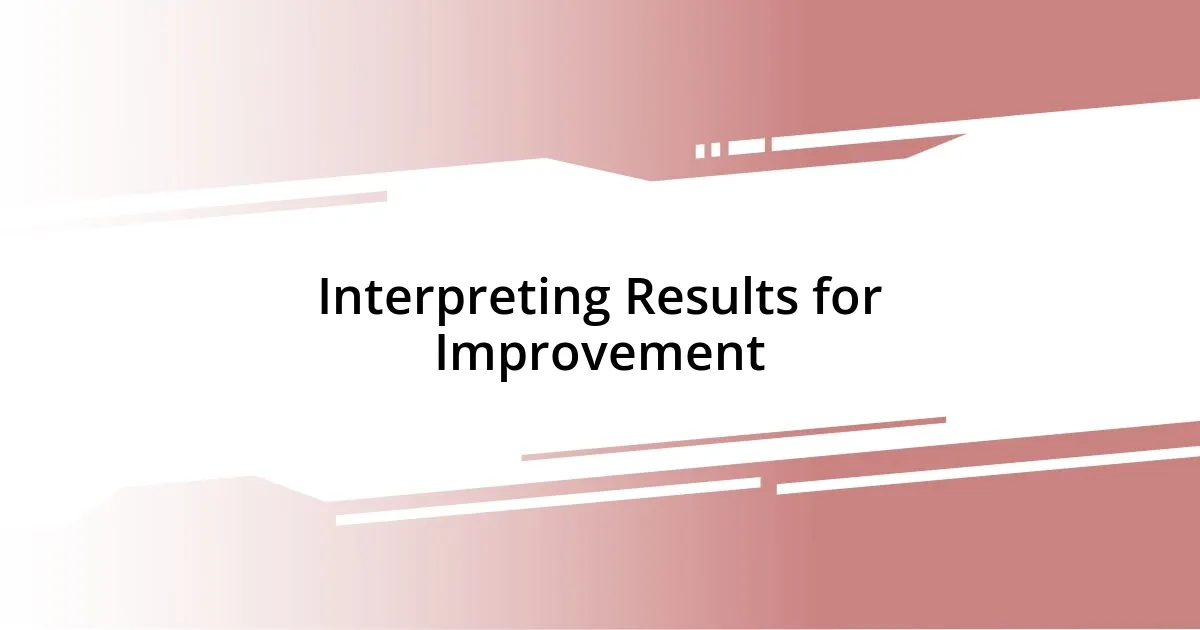Key takeaways:
- Performance analysis goes beyond metrics; it encompasses understanding qualitative factors that influence results.
- Clear, adaptable performance metrics are essential for guiding team efforts and motivating improvement.
- Identifying relevant and actionable KPIs helps align analysis with strategic business goals, enhancing focus on performance improvement.
- Contextual analysis of data—considering external factors and celebrating team successes—leads to more meaningful insights and improvements.

Understanding Performance Analysis
Performance analysis is more than just numbers; it’s about understanding the stories behind those numbers. When I look at data, I often find myself reflecting on moments where I encountered setbacks or surprising results. Have you ever experienced a dip in performance that seemed inexplicable at first? It’s in those times that I’ve learned the most about the nuances of what drives results.
I remember a specific project where initial metrics were disheartening. I felt a mix of frustration and curiosity, pushing me to dig deeper into the underlying factors. What if the context surrounding the performance was key, rather than just the metrics themselves? This experience taught me the importance of considering both qualitative and quantitative data, revealing insights that numbers alone might overlook.
Analyzing performance requires a holistic view. I often ask myself: Are we measuring the right things? It’s crucial to define success in meaningful ways, which often involves not just sales or productivity metrics, but also team morale and engagement levels. Integrating these aspects enriches the analysis, providing a fuller picture of performance that resonates on a personal and organizational level.

Importance of Performance Metrics
Understanding performance metrics is crucial for any individual or organization aiming to improve. I’ve seen firsthand how having clear metrics can transform performance. During one project, I was tasked with improving a team’s output. By setting specific and measurable goals, I noticed how everyone became more aligned and focused. It was an eye-opener for me—metrics not only guide actions but also motivate team members.
When I reflect on my experience, I remember a time when vague metrics made it difficult to identify where my team was struggling. This lack of clarity led to hours of unnecessary discussions without progress. Once I implemented precise metrics, it became clear which areas needed attention. I realized that performance metrics don’t just measure results; they illuminate the path to success.
Furthermore, metrics are not static; they evolve as circumstances change. I often revisit and recalibrate the metrics to ensure they reflect our current goals. This adaptability has proven essential in my work, helping me learn that what works today might not work tomorrow. It emphasizes the importance of continuous analysis and adjustment in performance metrics.
| Metric | Importance |
|---|---|
| Sales Growth | Indicates market response and effectiveness of strategies |
| Customer Satisfaction | Reflects product/service quality and influences loyalty |
| Employee Engagement | Deduces overall morale and productivity within teams |

Identifying Key Performance Indicators
Identifying key performance indicators (KPIs) is a pivotal step in my analysis process. I often find myself diving into data only to realize that the right KPIs can illuminate essential truths about performance. For instance, during a campaign that didn’t yield the expected results, I shifted my focus to understanding user engagement metrics instead of just sales figures. That change opened my eyes to where we could improve, highlighting the importance of aligning KPIs with actual business objectives.
To pinpoint the most impactful KPIs, I recommend considering the following:
- Relevance: Ensure the KPI aligns with strategic goals and reflects what you want to achieve.
- Measurability: Choose KPIs that can be quantifiable, allowing for easy tracking and analysis.
- Timeliness: Look for indicators that provide real-time data, enabling prompt decision-making.
- Actionability: Select KPIs that drive action and foster improvements, not just academic interest.
In my experience, identifying the right indicators can often feel like uncovering hidden treasures. One time, while assessing a product launch, I tracked customer feedback extensively, which was initially an afterthought. This focus on qualitative feedback led me to tweak our messaging significantly, resulting in a much better reception than anticipated. Discovering those insightful metrics truly validated the importance of selecting KPIs that resonate with both consumers and internal teams.

Data Collection Techniques
Data collection techniques play a vital role in shaping how we analyze performance metrics. In my experience, the most effective method has often been qualitative interviews, where I personally connect with team members to gather rich insights. This approach allows me to capture underlying feelings and motivations, which numbers alone can’t express. Have you ever noticed how a conversation can shift your perspective? I remember a time when a casual chat revealed why a team member felt disengaged, leading to a quick adjustment that turned the project around.
On the quantitative side, I often rely on surveys and feedback forms to collect data systematically. When developing a new product, I distributed a short survey to gauge customer interests and pain points. The response rate was surprisingly high, and what blew me away was how the insights helped shape our features to better meet customer needs. I learned that tapping into direct feedback creates a sense of ownership and shows that we truly value our customers’ opinions.
Another technique I’ve found beneficial is observational data collection. I recall a workshop where I observed my team during a brainstorming session. By watching their interactions and reactions, I gathered valuable information about group dynamics that wasn’t evident from meeting notes. It made me wonder—how often do we overlook the power of simply watching? This kind of data offers a different layer of understanding since it highlights real-time behaviors and can spark further questions about team collaboration and creativity.

Analyzing Performance Data
Analyzing performance data is all about sifting through the numbers to find stories that resonate with our goals. I often lean on data visualization tools to transform complex spreadsheets into visual insights that are easy to understand. For example, I once took a jumbled dataset and turned it into a series of colorful graphs. The clarity that emerged allowed my team to see trends we hadn’t noticed before, igniting a meaningful discussion that led to new strategies.
When I’m diving into the data, I don’t just look for averages; I delve into outliers. These anomalies can reveal unexpected opportunities or risks. I recall an instance where I noticed a sharp dip in user retention. Instead of glossing over it, I investigated further and discovered a recurring pain point in the user experience. Addressing that one issue transformed our customer interactions and significantly boosted retention rates. Have you ever had a single piece of data change your entire outlook on a project?
There’s also a palpable sense of urgency in analyzing performance data regularly. I like to set aside dedicated time each month to review performance at a tactical level. During this reflection, I ask myself, “What worked? What didn’t?” This practice has often led to immediate adjustments, like refining our marketing approach based on campaign performance metrics. It’s fascinating how a schedule can make data analysis feel like a continuous dance of discovery instead of a static end-of-quarter review. Embracing this iterative process not only keeps the team agile but also fosters a culture of responsiveness and innovation.

Interpreting Results for Improvement
To improve performance effectively, I believe it’s essential to frame our interpretation of results around actionable insights. Once, while evaluating a marketing campaign, I found that conversion rates were stagnating. Instead of merely accepting those numbers, I posed a critical question: “What specific tactics are driving this performance?” By breaking down the data and examining each component, I was able to pinpoint an underperforming ad set, leading to a strategic pivot that ultimately revived our engagement rates.
Interpreting results isn’t just about identifying weaknesses; it also provides a fantastic opportunity to celebrate the wins. I recall when my team achieved a 20% increase in productivity after implementing a new workflow tool. Reflecting on what sparked this change, I gathered the team for a discussion. We shared our thoughts on what aspects of the tool resonated best and how we could further enhance its use. This not only reinforced positive behaviors but also created a sense of ownership and pride in our achievements.
Another insight I’ve gleaned is the importance of context in analysis. Numbers don’t exist in a vacuum; they tell the story of our efforts within a particular backdrop. For instance, when sales figures dropped during a seasonal change, I took a moment to consider external factors like market trends and consumer behavior. This comprehensive perspective allowed me to guide my team in adjusting our strategies in anticipation of future fluctuations. Have you ever thought about how external influences can reshape your interpretation of success? It’s moments like these that remind me that a layered approach to data analysis often leads to the most impactful improvements.














